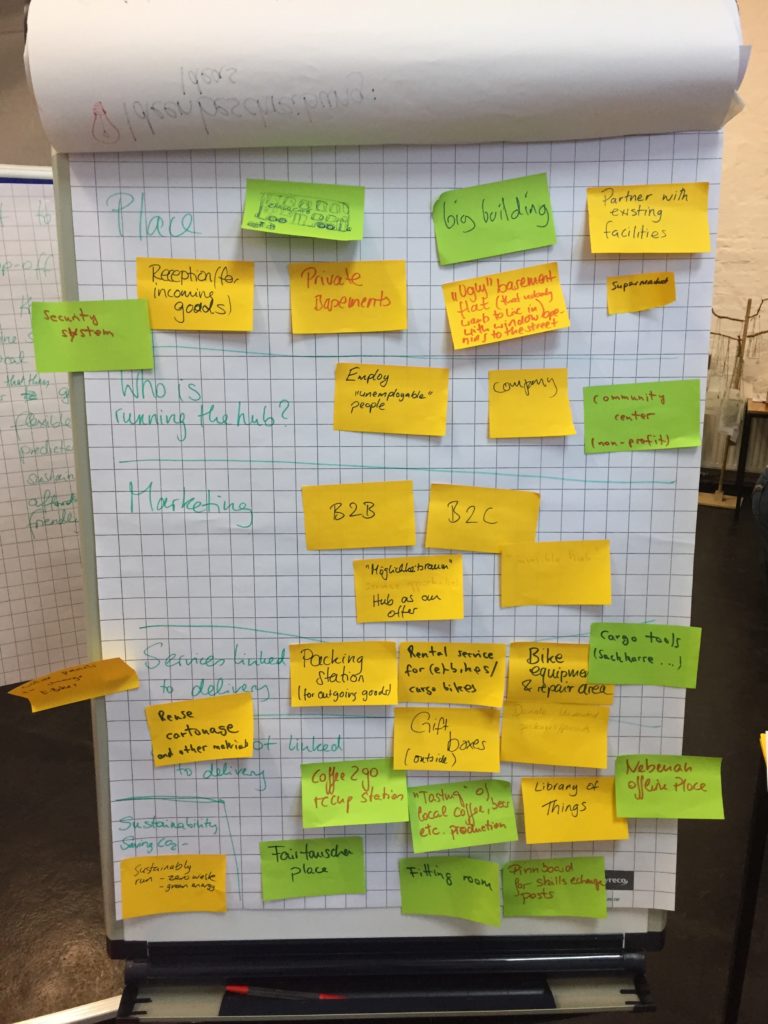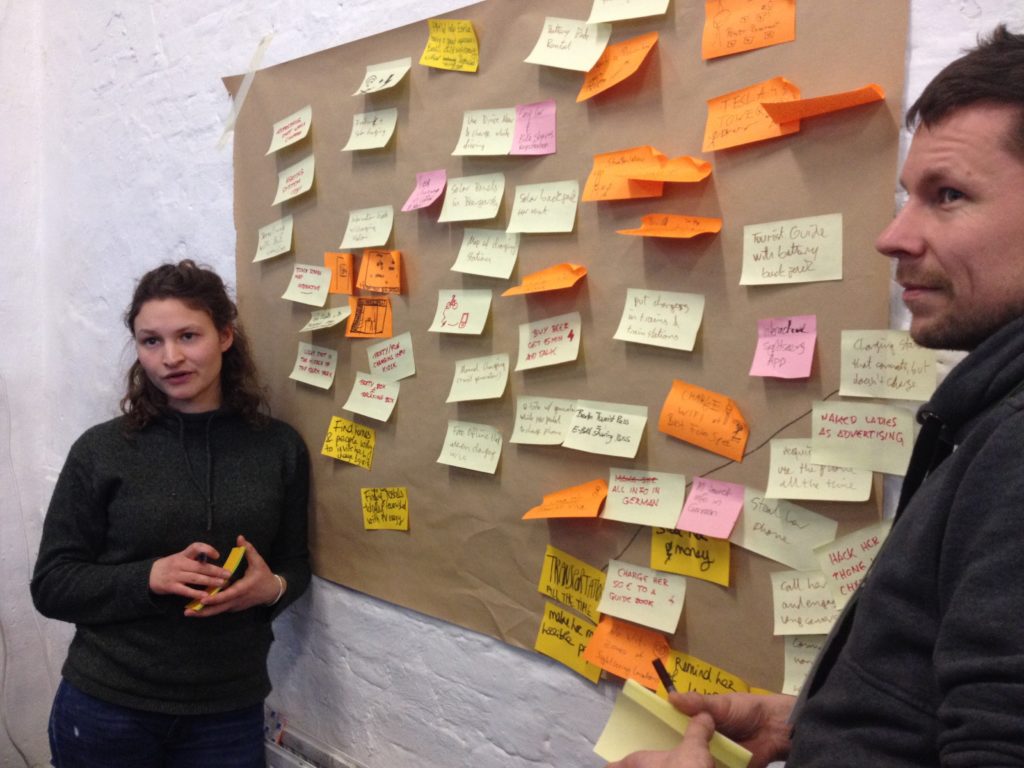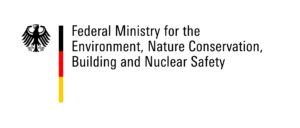
On March 3rd 2018, about 20 people met for the first GreenBuzz Berlin Sustainability Lab at Betahaus in Kreuzberg to work jointly on two challenges that have been proposed by active members of the GreenBuzz community in Berlin.
Challenge 1 addressed the idea of creating a “drop-off hub” in Kreuzberg for online shoppers and local business with the goal to receive parcels with bicycles in a flexible, predictable, sustainable, affordable and friendly way. It was run by Mika Koopmann from ImagineCargo and facilitated by Maren Beverung.
Challenge 2 started with the intention to find a way to help e-commuters feel comfortable in the city and reduce CO2 levels through the use of Suncrafter’s Urban Solar Power hardware. It was run by Bryce Felmingham from SunCrafter Solar Generation and facilitated by Aurélie Ferron from Protellus.
Both challenges were addressed in teams of about 10 people and we will describe the process and results for each challenge in the following.
Neighborhood “Drop-Off Hub” Kreuzberg
After several ideas ranging from creating a “Kiezkaufhaus” over supporting the “Solidarische Landwirtschaft” to creating an awareness campaign to buy locally have been discussed, a focus was set on the needs of online shoppers and their current barriers. While online shopping contributes to sustainability by reducing large heated and lit up department stores to highly effective warehouses, it still raises the question of how to best distribute the bought goods to the end-users. Especially with today’s demands for job flexibility, various needs like reliability, flexible, traceability, easy returns, and a
good feeling when ordering are yet largely unaddressed. As barriers, a lack of choice of delivery service, difficult parking situations, time pressure, price sensibility, language barriers, and traffic situation have been identified. Based on these insights, criteria for a hub have been collected as shown in figure 1. Ideally the solution would save CO2 through less traffic (delivery vans) on the streets because of a centralisation aspect as well as the possibility to deliver parcels by cargo bikes (from the hub to the end-consumer). Based on these findings, an action plan has been devised, comprising research tasks to find best-practices and existing approaches, developing a budget and identifying funding opportunities, investigating legal issues, scouting possible locations and forming a network of interested parties. Over the course of the next few weeks these actions should be put into practice and soon we will hopefully see the first neighborhood “Drop-Off Hub” in action, somewhere in Kreuzberg.

Urban Solar Power Stations
The Urban Solar project is a new concept from SunCrafter to help improve the quality of life in cities and reduce CO² emissions produced from within. With the aid of upcycled solar panel generators, charging stations (for e-bike, phones, cameras etc) can be strategically positions throughout the local community to increase e-mobility and help make renewable energy and circular economy products part of more people’s lives. The Sustainability Lab Kreuzberg was a great opportunity to pitch this idea to a bunch of sustainability enthusiasts and receive honest and constructive feedback to help further develop the concept to best cater for the local area of Kreuzberg.
After the pitch, the workshop participants divided into two teams. Aurélie Ferron, a Design Thinking coach, led the SunCrafter team. She led us through a detailed process of finding out who our market is, what the market needs and how to tweak our product to best cater for them. Aurélie had our team divide into groups several times, each time working with new people on new tasks, from interviewing people on the streets of Kreuzberg to brainstorm solutions for problems. Each task brought our product closer to a viable and useful tool for the people of Kreuzberg to reduce CO² emissions.
Each team brainstormed solutions for the challenge at hand. The number of ideas discussed per team was around 50 (as you can see in figure 2). However, each team focused on one winning idea which they prototyped.
With the goal to support free solar phone/laptop/e-bike charging, wi-fi and e-info kiosk, the team developed two interesting and convincing concepts. The first is a single unit info & recharge point with the added bonus of a vending machine that provides organic and regional produce. The idea is to provide solar islands that allow people to take a break in the sun, recharge (themselves, their phone or e-bike) and possibly eat something healthy.
The second concept is an off-grid solar powered outdoor co-working space for parks and other public areas. The idea is to improve the quality of the working life and allow people to be able to be productive while enjoying the sun and fresh air.
Because the user research led the team away from e-commuters, the ideas have less impact on the co2 levels of the city as hoped initially. However, the use of solar panels as source for computer and phone charging does reduce the need for fossil fuels as energy for this use. Furthermore, the ideas have one major environmental benefit: to have solar panels in the top of mind of people, and to build trust in solar energy.
The team will meet again to decide on a concept and work on defining it. A product name and team name will evolve and once the team is united and working in the same direction, tasks for design, research and networking will be delegated.

Task will include:
- Researching current similar projects
- Research government regulations
- Contact partners and relevant events
- Draft visualisations of product design
- Brainstorm and document locations for use
Over the course of the next few weeks this team will meet again and start putting their ideas into a viable, mobile prototype that can be setup at various locations in spring and summer to test user acceptance and develop further usages and design options for the product.
Based on these results, we are now eagerly awaiting the first prototypes in action and continue to follow and support the groups throughout the process. Involving and informing the public about these projects as well as additional projects following from the upcoming Sustainability Labs in Neukölln on July 1st and Wedding on September 15th are a core responsibility of GreenBuzz Berlin in that regard.
Please get in touch with us, if you are interested to put out a challenge for one of our next labs or if you would like to participate in a lab to make your own Kiez more sustainable. All information about upcoming events and challenges can be found at https://greenbuzzberlin.de/sustainability-labs/ and on our facebook page at https://www.facebook.com/greenbuzzberlin. You can directly register for a challenge at https://goo.gl/forms/ZKVx1pHtcRlfkh7A2
The Sustainability Labs are funded by Bundesministerium für Umwelt, Naturschutz, Bau und Reaktorsicherheit aufgrund eines Beschlusses des Deutschen Bundestages / Funded by the Federal Ministry for the Environment, Nature Conservation, Building and Nuclear Safety due to a decision of the German Federal Parliament.
- #005 – Plantyflix - November 10, 2020
- #003 – Dycle - September 24, 2020
- #002 – SunCrafter - September 22, 2020


Wow, that’s amazing, keep sharing this kind of stuff.
Thanks for sharing a fantastic article. What a wonderful Blog.
There are also measures we can take in our homes to decrease CO2 emissions.
Adjust your water heater. Your water does not need to be painfully scalding hot. By reducing the temperature from 140 degrees Fahrenheit to 120, you will decrease your CO2 emission. Insulating your water heater or going tankless can also decrease carbon dioxide.
Shut down and unplug devices. Even when you’re not using electronic devices, they use energy when plugged in. Turn off and unplug items such as a cell phone charger, coffee pot or hair dryer when not in use. Make it easier by plugging all items into a power strip.
Hang clothes out to dry. Your dryer is one of the worse offenders for CO2 emissions. It’s summer, so take advantage of the few months we have of warm weather by getting a clothesline. If you can hang clothes somewhere inside during the winter months, you will save even more energy!